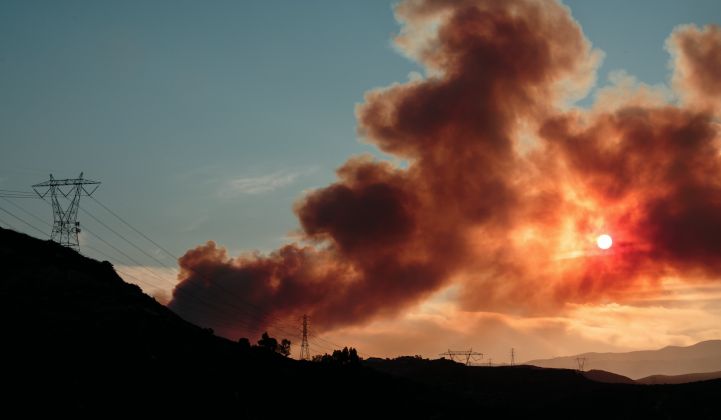Less than two weeks after emerging from an 18-month bankruptcy caused by its multibillion-dollar wildfire liabilities, Pacific Gas & Electric faces yet another lawsuit for a 2019 fire that California investigators say was caused by its power lines.
On Thursday, the state's Department of Forestry and Fire Protection confirmed that the Oct. 2019 Kincade fire was caused by a failure of a PG&E transmission line in Sonoma County. The fire burned 77,758 acres, destroyed 374 structures and forced the evacuation of about 190,000 people, though no one was killed in the blaze.
PG&E had already conceded that a failed jumper cable on a transmission line was the likely cause of the fire and has set aside $600 million in anticipation of covering resulting damages — a figure at “the lower end of the range” of potential losses, the utility stated in its first-quarter earnings report.
On Wednesday, attorneys representing individuals and businesses harmed by the Kincade fire filed a lawsuit accusing PG&E of failing to maintain the power lines that broke down, despite knowing that its grid network presented significant safety issues. The complaint (PDF) filed in Sonoma County Superior Court cites the utility’s record of diverting grid maintenance budgets to boost corporate profits, as well as its long record of being found at fault for causing some of the state’s deadliest fires over the past decade.
PG&E decided against shutting off power to the 230-kilovolt transmission line before it failed, although it did de-energize much of its lower-voltage transmission and distribution network in the area in an attempt to prevent the lines from causing fires. That outage left millions of people without power and led to widespread complaints from residents and local governments, although it didn’t feature the same communications breakdowns and poor preparations that marked the utility's first major public-safety power shutoff (PSPS) event earlier that month.
PG&E has said it will need to continue these fire-prevention blackouts for years to come while it continues to inspect and repair its grid in an effort to avoid causing more fires amid hot, dry and windy conditions. It’s also planning to spend about $175 million to prepare 450 megawatts of diesel generators to be available to back up neighborhoods and facilities likely to face outages this summer and fall.
But PG&E’s decision not to de-energize the power line that caused the Kincade fire somewhat mirrors its decision in Nov. 2018 to maintain power flow on the high-voltage transmission line that ended up causing the Camp fire in Northern California's Butte County, which destroyed the town of Paradise and killed 84 people. PG&E filed for Chapter 11 bankruptcy protection in January 2019 in the face of an estimated $18 billion in damages it faced from causing that fire; last month the utility pled guilty to 84 counts of involuntary manslaughter for its role in those killed in the incident.
PG&E has since shut down the transmission line that caused the Camp fire and significantly expanded the scope of its PSPS events, as well as changing how it measures the risk of leaving its grid energized in high wind conditions. It has also faced orders from the federal judge overseeing its criminal probation for its role in the 2010 San Bruno natural-gas pipeline explosion to drastically improve its grid inspection and maintenance regimen.
But this week’s findings that PG&E caused the Kincade fire could force it to consider de-energizing a broader range of high-voltage lines as part of this year’s PSPS protocol. That, in turn, could threaten even broader blackouts across Northern California, Michael Wara, the head of Stanford University’s Climate and Energy Policy Program and a member of Gov. Gavin Newsom’s Wildfires Blue Ribbon Commission, told Greentech Media earlier this year.
The utility won bankruptcy court approval of its plan earlier this month, allowing it to access a $21 billion state fund to shield it and California’s other investor-owned utilities from massive fire liabilities. But it's also under strict state supervision to improve its safety culture and meet its wildfire-prevention goals. Failing to do so could expose PG&E to sanction or even state receivership under the terms of its agreement with the California Public Utilities Commission.
PG&E is in the midst of raising $9 billion in equity and $11 billion in debt as part of its $59 billion restructuring plan, which includes spending about $7.8 billion over the next three years on its wildfire-mitigation efforts. PG&E shares took a hit after its $5 billion common stock and equity offering late last month, but analysts say the key to its success or failure for its ongoing restructuring will hinge on whether it can prevent its grid from causing more wildfires this summer and fall.




